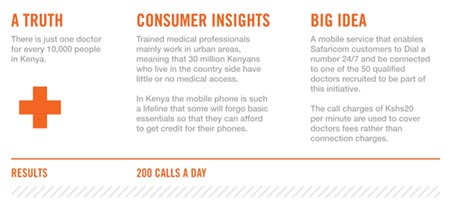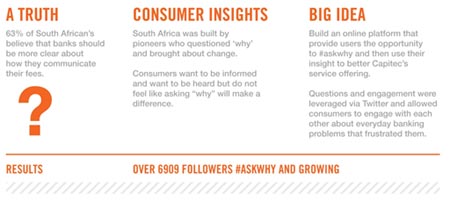Africa is a fusion of many cultures and no one archetype can define us. However, many African nations have similar needs in terms of social-economic development. Africa's digital revolution has arisen out of the common goal to ameliorate these issues and will be driven by social and commercial utility needs[1]. The real power of technology lies with the people that use it! [2] (video)
This is the era of people power
The African consumers' need for increased connectivity and better service delivery is fueling the tech boom and brands will need to acknowledge these needs and interests or risk being ignored. In this piece we look at what continental changes are fueling this growth and how brands will need to adjust their marketing communication to effectively leverage the opportunities that arise from these.
Understanding the African online playing field [3]
A regional focus on Nigeria, Ghana, Cameroon, Kenya, Uganda, Tanzania and South Africa:
- 83 million potential online users
- 27% annual growth in household internet penetration between 2009 -2013
- 58% cell phone penetration (11% smart phones & 89% feature phones)
- 22% online penetration in the markets - 30% of online users use smartphones/70% of online users use Feature Phones (WAP enabled)
- 1% Fixed broadband
Towards a connected Africa
Connectivity is a huge barrier to social and commercial communication in Africa and the reliance on fossil fuel is not able to keep up with the growing demand of nations. Alternative energy sources will need to be identified to ensure we drive sustainable growth on the continent. Ushahidi [4], a non-profit tech company, is one such organisation which has seen a need on the continent and sought to solve this need through technology. They have created a piece of hardware called BRCK which is an all-in-one portable power source, Wi-Fi hub, and cloud. This tech allows for uninterrupted internet access, the ability to charge multiple items on one power source and remote access for multiple users. We are now moving closer to an "always on" Africa driven by productivity and a growing connected middle class.
Towards elevating inequality
Kenya's tech boom is now being spearheaded by the development of the Konza technology city [5]. The development is expected to create approximately 20,000 direct jobs by the end of the year. The infrastructure expansion will result in cheaper technology across the belt of Africa, job creation, increased middle class buying power and accelerated economic growth.
mLearning - Educating the masses
Imagine not having to rely on text book deliveries. Imagine having an entire curriculum at a touch of a button no matter your race, gender or class. Imagine no more - it's a reality... UNESCO [6] launched a programme based on growing partnerships geared towards exploring how mobile technology can enable this achievement of education for all and now the continent has finally seen the commercial opportunity in this global initiative and have leveraged it to empower communities on a grass roots level. The implications for the implementation of this tech will lead to increased literacy, increased gender equality and a decrease in exploitation, allowing brands to effectively reach a bigger base of consumers.
Let's see it in practise: We take three problems and look at three solutions [7]:
The future is nigh!
- Glocalisation [8] - Africa is connected and in the race to remain relevant to consumers, brands have realised that there is not one mould to fit all. By adapting their global strategies to mirror local trends they have been able to remain relevant. This is driving increased localised global content, increased revenue streams as local talent is utilised more effectively with a stronger focus being put on accountability, standardization and quality.
- African Online Super Star is the phenomenon which has occurred as the continent becomes more connected. Users have the ability to now converse in real-time about current affairs and we are seeing the rise of the blogging super star [9]. Now, the everyday individual has a voice and the effect of this has seen a rise in community building, empowerment through information sharing and in some cases as a political change driver.
- eGovernance [10] relies on a similar model to mlearning and provides countries with the means to drive effective and efficient service delivery. Countries like Uganda have already started the process by undertaking cost and infrastructure impact studies. By 2020 we will be even closer to an efficient and transparent Government.
Implication for 2020?
Brand activities need to relate and evoke more than just a need to consume, whilst adding value to consumers at a personal level. Mobile technology will provide the interface to evoke this emotion and turn consumers into passionate advocates who generate peer-to-peer influence on your behalf. Consider the following:
Mobile
- Cheaper smartphones and feature phones are inevitable
- Increase in mobile led solutions that aid in the upliftment and empowering of the African consumer.
Commerce
Increased accountability and standardisation is inevitable as more International markets look to invest in online tech and content on the African continent.
Content
- Increase in local content as a few local mass publishers try to hold on to their audience in the light of start-up publishers.
- Quality content creation
- International publishers become globalised i.e. MSN Africa
Community
- Increased social interaction leading to the empowered community
Connected Consumer
- Expansion of connected lower class and subsequent growth in entry level phones
- Increase in growing middle class and entry level smartphones % increases
How as marketers and brand can we utilise these insights and turn them in to opportunities?
Three basics for building brands for a modern African consumer [11]
- Consumer-centric brands - Brands have a role to play in society and consumers want to see brands go beyond their product and give back, making a difference and transforming lives.
- Social business - Give the brands back to the fans. Consumers firmly believe that products and marketing actions should be co-created. Brands that offer true collaboration will connect.
- Synchronize, coordinate and harmonize - Brands need to behave as indispensable tools that connect people to information, content, services and experiences in ways that fit seamlessly into consumer's daily routine.
Let's see it in action. Here are two great examples using all three strategic pillars:
Safricom - Daktari 1525
Capitec Bank - #AskWhy tosimplify banking
How do we move from "just another brand" to life partner?
By the application of these three strategic platforms, what we envision in terms of a technological application will be irrelevant seeing as their will be no limits to how you can make your brand transcend channel and tech. We are well on our way to having a workable platform that can be harnessed and creatively executed across mobile channels, while always keeping the consumers' needs and wants top of mind.
The future of digital is in Africa limitless...
References
[1] Gareth Knight, 2013. Founder of Tech4Africa
[2] McKinsey & Company, 2012 The Social Economy
[3] Miniwatts Marketing Group. Internet World Stats, 2013: www.internetworldstats.com
[4] www.ushahidi.com
[5] www.konzacity.co.k
[6] www.unesco.org
[7] http://www.wired.co.uk/news/archive/2013-06/21/mfarm www.mprep.it
[8] www.peo.cambridge.org
[9] www.afronline.org
[10] www.communicationsafrica.com
[11] Most Contagious 2012 report
Updated at 11:15 on 9 September 2013

































